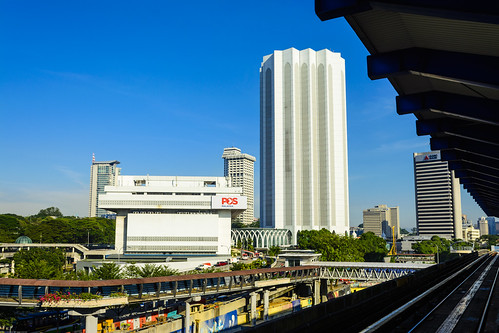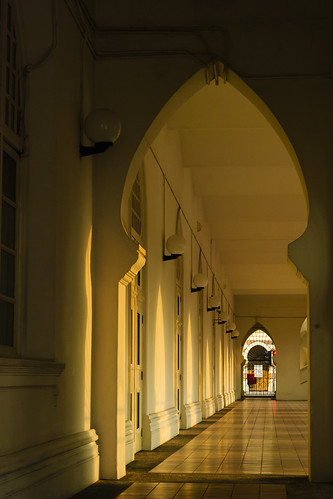The former General Post Office of Malaysia - An Indo-Saracenic building without domes
The former General Post-Office Building (above picture) is often mistaken for part of the Sultan Abdul Samad Building perhaps because they are situated adjacent to each other and striking similarities in their design. But the former General Post-Office is by no means part of the Sultan Abdul Samad Building. In fact the former General Post-Office was completed in 1907, ten years after the Sultan Abdul Samad Building was completed. It was where the General Post Office was housed until 1984 when GPO moved to the new building at Dayabumi Complex.
The history of postal service to and from Kuala Lumpur dates back to around 1880 when British administrators arrived in Kuala Lumpur. The procedure in later years was that, as soon as the mail steamer was sighted in Klang, the news was telegraphed to Kuala Lumpur, and the post office hoisted its flag to inform residents that mail would arrive shortly. The flag came down as a signal that the mail had arrived at the post office. Mail came from Europe direct to Penang by weekly service of the Peninsular and Oriental (P&O) Steam Navigation Company. There was another weekly P&O delivery of Malayan post to Rangoon whereas letters to Kuala Lumpur were forwarded via Penang to Klang. Besides steam ship mails were carried by various mode of transport such as train, bullock cart and runners. The rate of postal charges was 2 cents per half ounce until 1894 when it was raised to 3 cents.
Prior to establishing the first post office in 1889, which was housed in two small huts near the first Railway Station (1886 Railway Station), the post office was reported to have led a wandering existence.
After a couple of years, in mid 1890’s, the Post Office was relocated to the second building, a two-storey building on the south side of the Padang (Merdeka Square) – where the Music Museum and KL City Gallery are now seated. The upper floor was reserved as quarters for the postmaster while the post office took up the ground floor.
Upon the completion of the new Government Offices (now the Sultan Abdul Samad Building) in 1897, the post office moved to its south wing occupying the ground and upper floor. Due to expansion of the government departments, more land was needed to erect more buildings. The next building planned to be built was a new and separate place for the post office. Its move to a new building would provide much needed extra office space for the departments remaining in the new Government Offices.
However the targeted site, next to the south wing of the new Government Offices, where the government planned to build a new post office building was being occupied by the Chow Kit’s European and general store which was set up in 1892 and the landlord was Loke Yew.
After prolonged bargaining between Loke Yew and the government, Chow Kit eventually had to vacate his general store and as an exchange the government agreed on the 30-year lease to Loke Yew for a site at the corner of Clarke Street and Holland Road. It was on this site Loke Yew built the first department store in Kuala Lumpur which was leased to Chow Kit and named Chow Kit & Co Department Store completed in 1905. It is still standing strong now and had been turned into the Industrial Court.
After acquiring the site from Loke Yew the government made the necessary preparation to commence the construction. The design was ready in June 1904 which again was done by the Government architect, A.B. Hubback. Similar to other new government buildings along the perimeter of the Padang, the Indo-Saracenic architectural style was again adopted. This explains the remarkable similarity in design especially with the Sultan Abdul Samad Building located next door.
The contract was originally awarded to Towkay Choo Teck Lim in 1904 and the construction commenced right after that. Unfortunately the original contractor faced financial troubles and was unable to continue the work. In 1905 the project was taken over by Singaporean contractor, Messrs. Walter Pallister, who was more financially sound and more experienced in undertaking big projects in Singapore.
The building was eventually completed in 1907 at a total cost of $100,000.00 Straits Dollars. Upon completion the building added another landmark of Kuala Lumpur especially within the Civic Heart of Kuala Lumpur along the perimeter of the Padang. The architecture of the building again adopted the Indo-Saracenic architectural style which is the hybrid of Mughal architecture of northern India and European style of architecture like English Gothic, Neo-Classical and Neo-Renaissance.
The Mughal part can be seen in repetitive pointed horse shoe arches on the ground floor and upper floor of the building as well as its spires. While the leaf pediments on parapet wall and the octagonal towers containing spiral staircase on each side of the building remind us of the English Gothic and European style of architecture. It is also worth noting that this building is the only Indo-Saracenic buildings designed by Hubback without any domes!
The General Post Office occupied this building from day one until 1984 when the General Post Office was relocated to a much bigger, modern and newly completed building at the Dayabumi Complex.
The former General Post Office building was transformed into a Court of Appeal in 1992. The building has been gazetted as one of the country's heritage buildings.
REFERENCES
Chin, K.Y., & Chen, V.F. (1998). Kuala Lumpur, a sketchbook. Singapore: Archipelago Press.
Gullick, J.M. (2000). A history of Kuala Lumpur 1857-1939. Kuala Lumpur: MBRAS
National Textile Museum. (2014). AB Hubback: An architectural celebration in Malaya. [Exhibition Catalog]. Kuala Lumpur, Malaysia.
Robson, J.H.M. (1934). Records and Recollections. (1889-1934). Kuala Lumpur: Kyle, Palmer & Co.
Notes from Selangor. Public Buildings. (1906, December 17). The Straits Times, p.5.
The history of postal service to and from Kuala Lumpur dates back to around 1880 when British administrators arrived in Kuala Lumpur. The procedure in later years was that, as soon as the mail steamer was sighted in Klang, the news was telegraphed to Kuala Lumpur, and the post office hoisted its flag to inform residents that mail would arrive shortly. The flag came down as a signal that the mail had arrived at the post office. Mail came from Europe direct to Penang by weekly service of the Peninsular and Oriental (P&O) Steam Navigation Company. There was another weekly P&O delivery of Malayan post to Rangoon whereas letters to Kuala Lumpur were forwarded via Penang to Klang. Besides steam ship mails were carried by various mode of transport such as train, bullock cart and runners. The rate of postal charges was 2 cents per half ounce until 1894 when it was raised to 3 cents.
Prior to establishing the first post office in 1889, which was housed in two small huts near the first Railway Station (1886 Railway Station), the post office was reported to have led a wandering existence.
After a couple of years, in mid 1890’s, the Post Office was relocated to the second building, a two-storey building on the south side of the Padang (Merdeka Square) – where the Music Museum and KL City Gallery are now seated. The upper floor was reserved as quarters for the postmaster while the post office took up the ground floor.
Upon the completion of the new Government Offices (now the Sultan Abdul Samad Building) in 1897, the post office moved to its south wing occupying the ground and upper floor. Due to expansion of the government departments, more land was needed to erect more buildings. The next building planned to be built was a new and separate place for the post office. Its move to a new building would provide much needed extra office space for the departments remaining in the new Government Offices.
 |
| The former General Post Office at the corner of Jalan Raja and Market Street (now Lebuh Pasar Besar) |
However the targeted site, next to the south wing of the new Government Offices, where the government planned to build a new post office building was being occupied by the Chow Kit’s European and general store which was set up in 1892 and the landlord was Loke Yew.
After prolonged bargaining between Loke Yew and the government, Chow Kit eventually had to vacate his general store and as an exchange the government agreed on the 30-year lease to Loke Yew for a site at the corner of Clarke Street and Holland Road. It was on this site Loke Yew built the first department store in Kuala Lumpur which was leased to Chow Kit and named Chow Kit & Co Department Store completed in 1905. It is still standing strong now and had been turned into the Industrial Court.
After acquiring the site from Loke Yew the government made the necessary preparation to commence the construction. The design was ready in June 1904 which again was done by the Government architect, A.B. Hubback. Similar to other new government buildings along the perimeter of the Padang, the Indo-Saracenic architectural style was again adopted. This explains the remarkable similarity in design especially with the Sultan Abdul Samad Building located next door.
The contract was originally awarded to Towkay Choo Teck Lim in 1904 and the construction commenced right after that. Unfortunately the original contractor faced financial troubles and was unable to continue the work. In 1905 the project was taken over by Singaporean contractor, Messrs. Walter Pallister, who was more financially sound and more experienced in undertaking big projects in Singapore.
The building was eventually completed in 1907 at a total cost of $100,000.00 Straits Dollars. Upon completion the building added another landmark of Kuala Lumpur especially within the Civic Heart of Kuala Lumpur along the perimeter of the Padang. The architecture of the building again adopted the Indo-Saracenic architectural style which is the hybrid of Mughal architecture of northern India and European style of architecture like English Gothic, Neo-Classical and Neo-Renaissance.
The Mughal part can be seen in repetitive pointed horse shoe arches on the ground floor and upper floor of the building as well as its spires. While the leaf pediments on parapet wall and the octagonal towers containing spiral staircase on each side of the building remind us of the English Gothic and European style of architecture. It is also worth noting that this building is the only Indo-Saracenic buildings designed by Hubback without any domes!
The General Post Office occupied this building from day one until 1984 when the General Post Office was relocated to a much bigger, modern and newly completed building at the Dayabumi Complex.
 |
| The new General Post Office at the Dayabumi Complex |
The former General Post Office building was transformed into a Court of Appeal in 1992. The building has been gazetted as one of the country's heritage buildings.
 |
| The front facade of the former General post Office |
 |
| An arcade inside the former General Post Office |
 |
| The former General Post-Office Building |
REFERENCES
Chin, K.Y., & Chen, V.F. (1998). Kuala Lumpur, a sketchbook. Singapore: Archipelago Press.
Gullick, J.M. (2000). A history of Kuala Lumpur 1857-1939. Kuala Lumpur: MBRAS
National Textile Museum. (2014). AB Hubback: An architectural celebration in Malaya. [Exhibition Catalog]. Kuala Lumpur, Malaysia.
Robson, J.H.M. (1934). Records and Recollections. (1889-1934). Kuala Lumpur: Kyle, Palmer & Co.
Notes from Selangor. Public Buildings. (1906, December 17). The Straits Times, p.5.

Mү гelatives every time say that I amm wasting my time һere
ReplyDeleteat web, however I know I am getting knowledge everyday by reading ѕuch nice posts.
Hello everyone, it's my first pay a quick visit
ReplyDeleteat this web page, and paragraph is actually fruitful for me, keep up posting such articles or reviews.